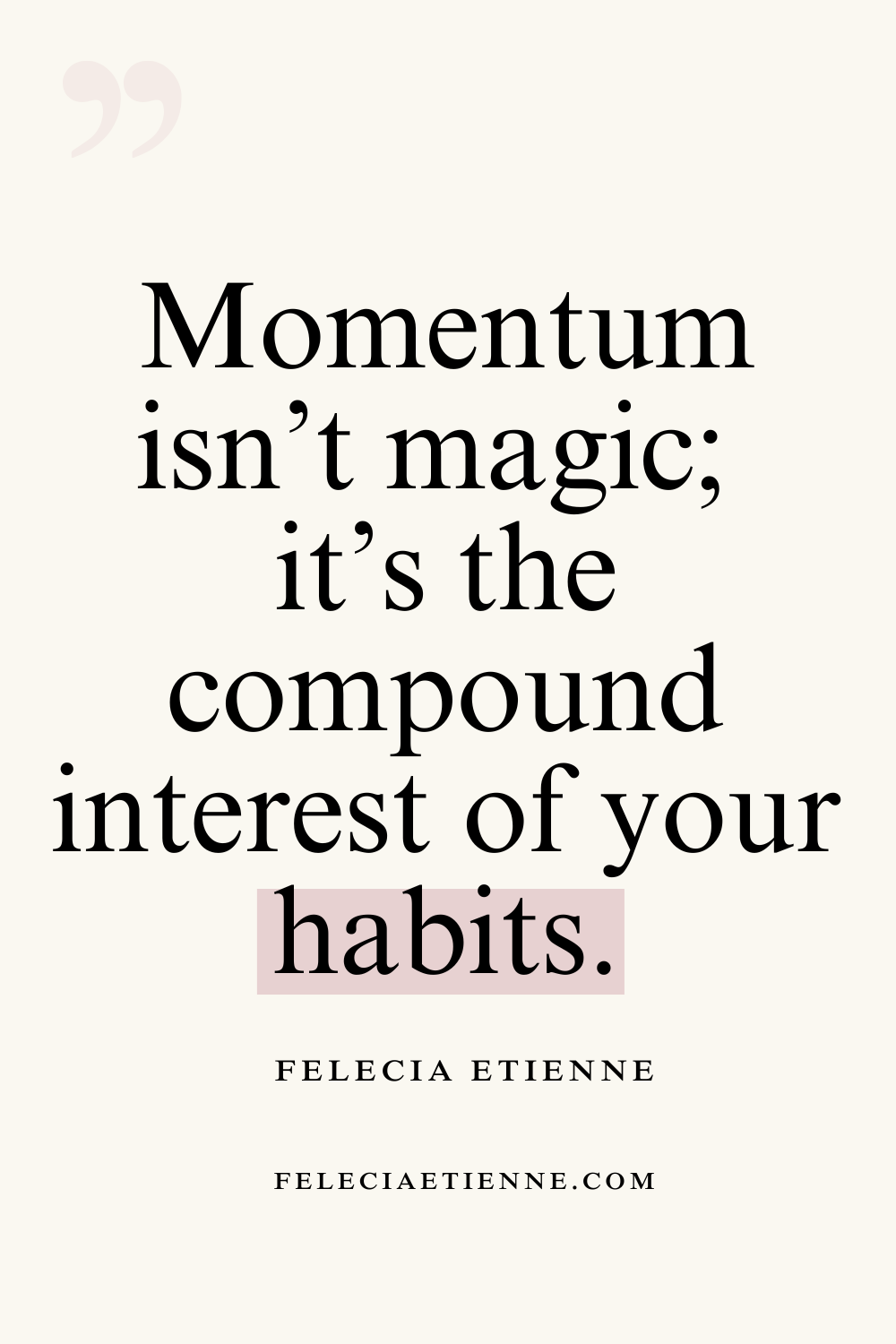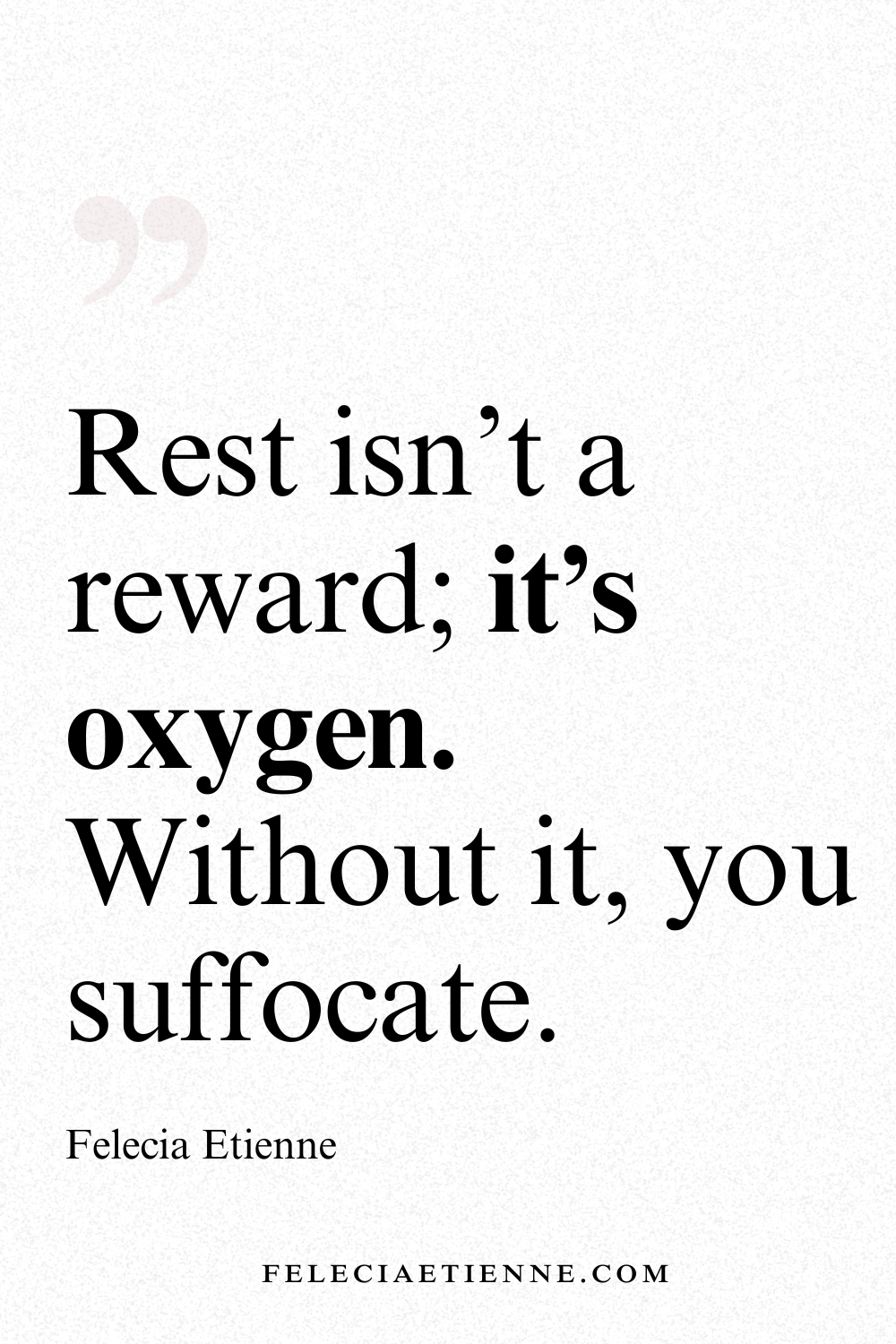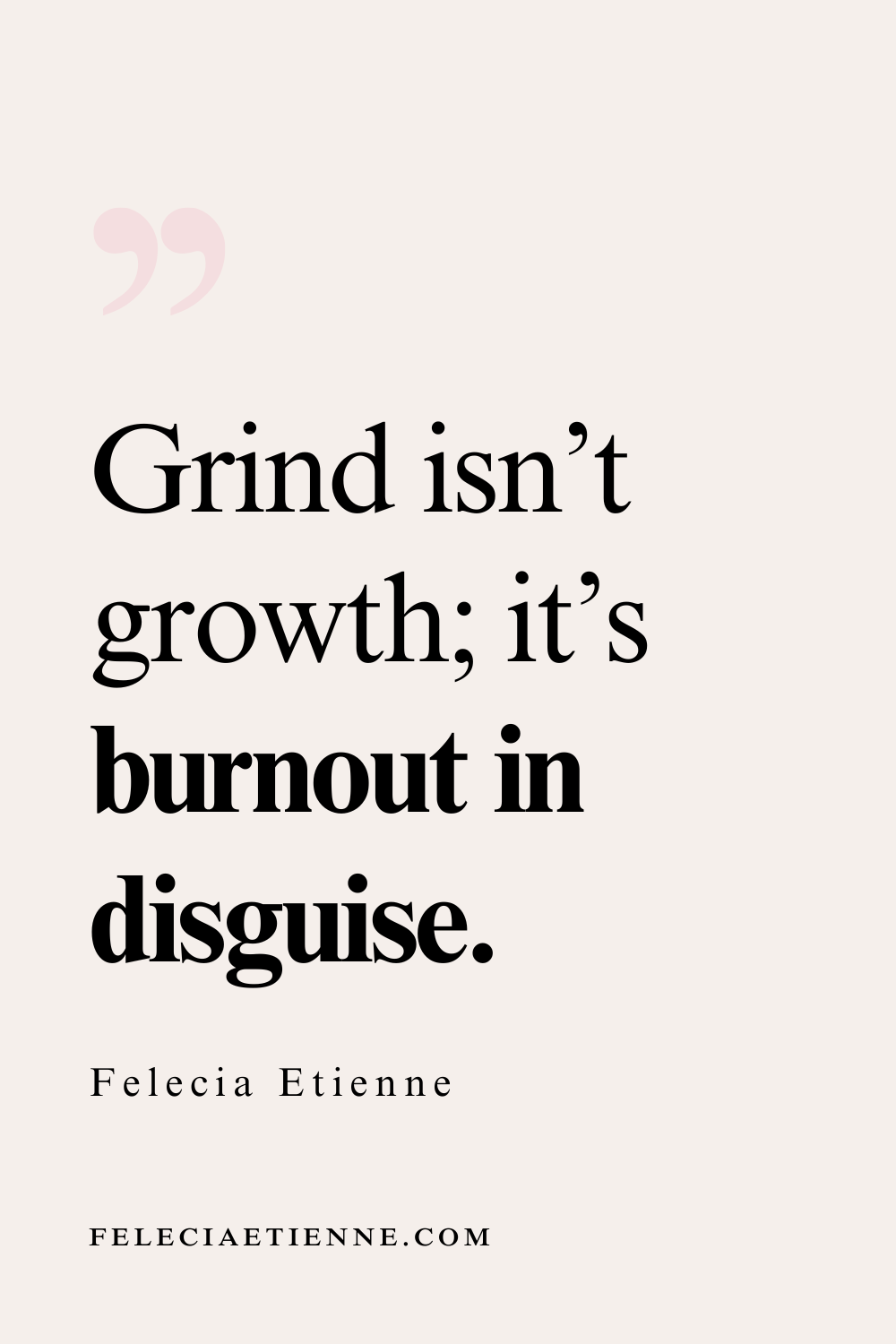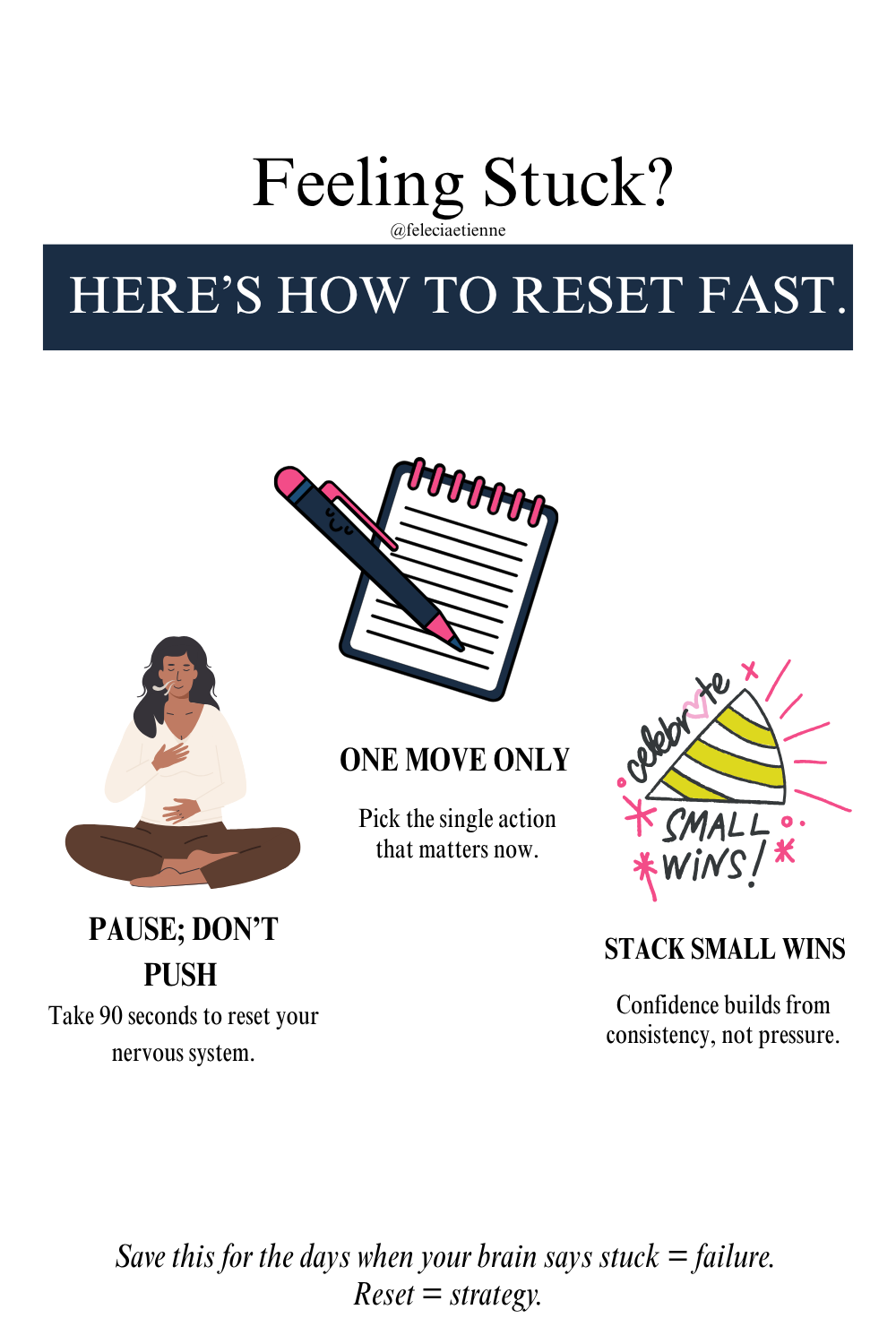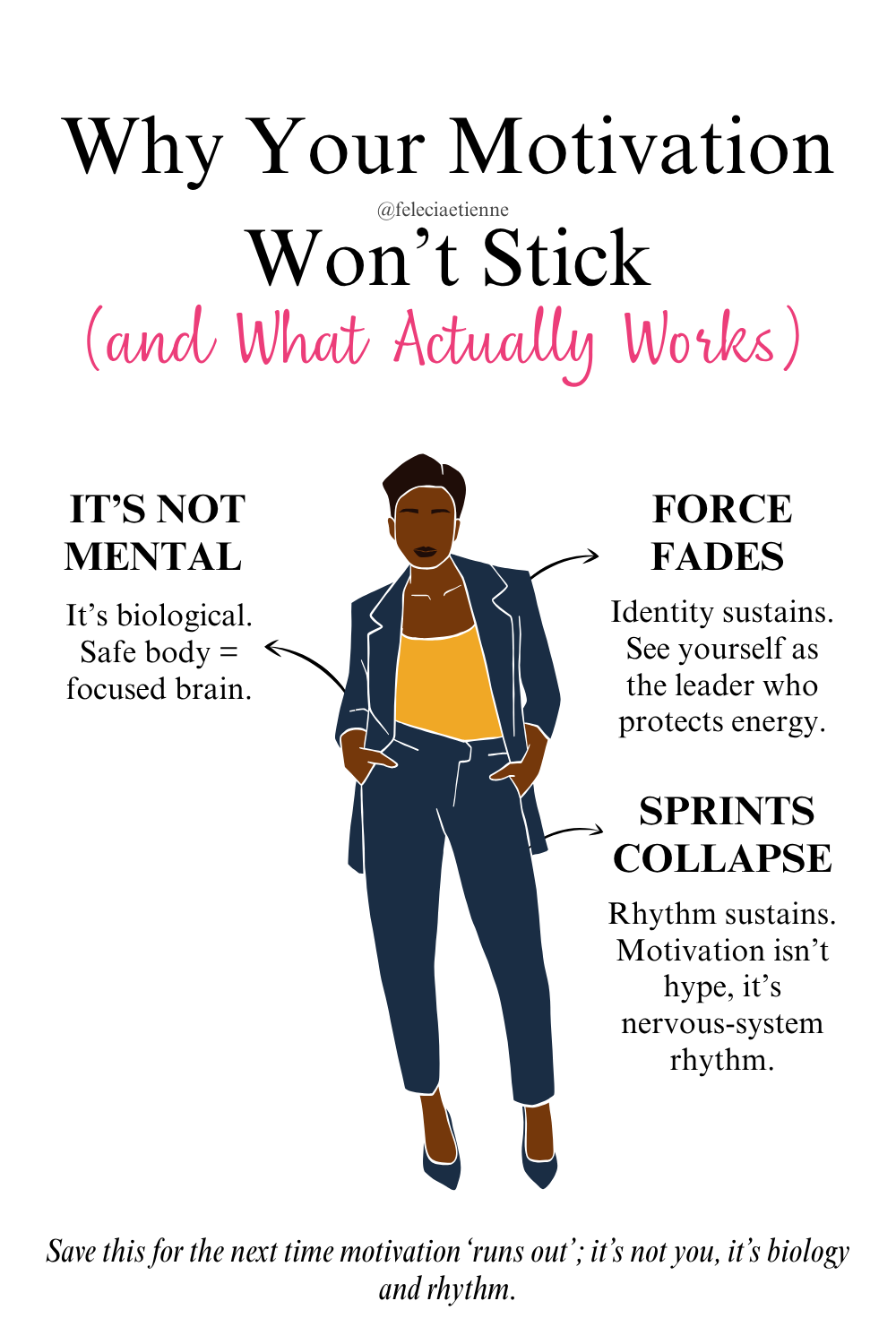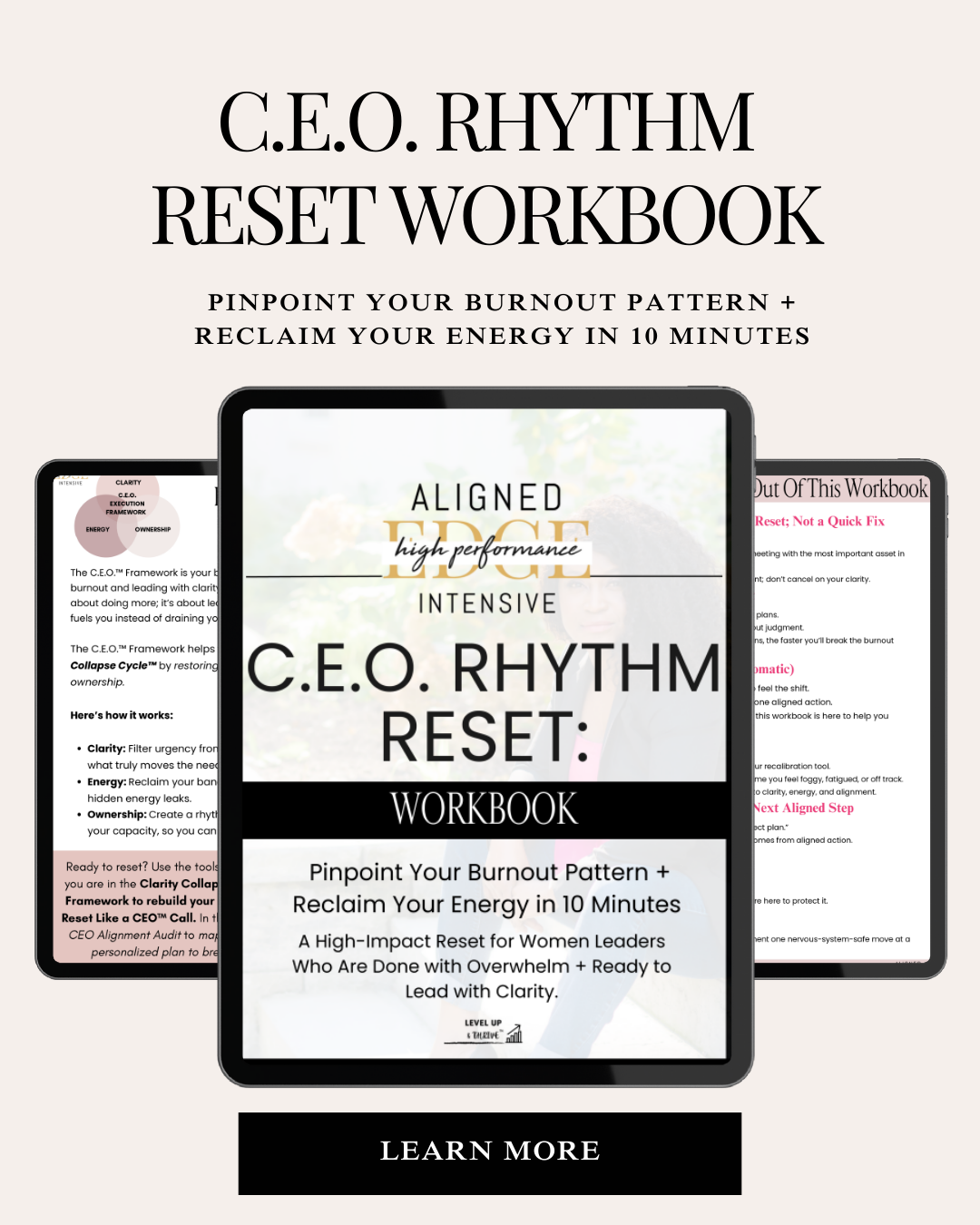Why Your Plans Keep Stalling (And How to Reset Your Rhythm Without Guilt)
When Plans Look Perfect on Paper; But Still Fall Apart
You start the week with big plans and even bigger ambition, but by Friday, you’re staring at a calendar full of half-finished tasks, stalled projects, and a lingering sense of “Why can’t I just follow through?”
Here’s the truth: It’s not that you’re lazy, scattered, or not cut out for success. It’s that your systems are working against you, not for you.
High achievers don’t stall because they lack ambition; they stall because their systems are misaligned. Stress hijacks clarity like a fog rolling in during rush hour; you can’t see the road ahead, and every decision feels harder than it should. The harder you push, the further you slip from momentum.
👋 I’m Felecia Etienne, Certified High-Performance Coach, Leadership and Mental Fitness Expert, and creator of the CEO Aligned Execution Framework™. After two decades leading in Fortune 500 companies and now coaching ambitious entrepreneurs and leaders, I know what it feels like to hit every milestone but secretly wonder: Why doesn’t this feel like momentum?
I’ve been there, mapping out every detail of my week, only to feel like I was spinning my wheels by Friday. What I’ve learned is this: It’s not about doing more. It’s about aligning your rhythms with the pace of your life.
In this blog, you’ll learn:
The neuroscience behind why even your best-laid plans collapse under stress and how to fix it.
The hidden saboteurs (like perfectionism and over-achieving) quietly derailing your execution, and how to spot them.
A nervous-system-safe method to reset your rhythm, ditch the chaos, and reclaim momentum without guilt.
Let’s dive in.
“Momentum isn’t magic; it’s the compound interest of your habits.”
The Illusion of the Perfect Plan
You start the week with a plan so precise, it feels like a masterpiece.
Meetings, deadlines, projects; lined up like dominoes. If you hit each one, the whole week should fall neatly into place.
And in that moment of planning? It feels good.
Your brain loves the clarity. You can almost see yourself breezing through it all, finishing strong, finally ahead of the curve.
But then reality steamrolls your structure.
The proposal you swore you’d send on Tuesday is still sitting in Drafts.
The launch prep is “90% done” again.
Your days fill with tasks you never even planned for.
And by Friday, you’re staring at the chaos, whispering: “Next week will be different.”
Here’s why this keeps happening:
Planning and execution live in different parts of the brain.
The prefrontal cortex, the CEO of your brain, lights up when you make a plan. That’s why planning feels productive, even energizing. But execution doesn’t live there. Execution runs through the basal ganglia, the autopilot center where habits and patterns live.
Think of it like this:
Your prefrontal cortex is the architect, designing the perfect blueprint for your goals. But your basal ganglia is the builder.
This part of your brain is actually a "habit-forming center" (ScienceDaily), responsible for all those routines you do on autopilot. If that builder is stressed, distracted, or just running on old, ingrained habits, your brilliant blueprint won't matter. The house won’t get built.
So while your prefrontal cortex dreams in structure, your execution depends on rhythm. And if your nervous system isn’t aligned, the plan you created on Sunday collapses by Tuesday.
This is the illusion of the perfect plan: it looks flawless on paper, but without rhythm, it never survives real life.
The good news? Rhythm is something you can create, and when you do, your plans finally start to work with you, not against you.
“You’re not drowning because you’re weak. You’re drowning because you’re fighting a current that was never meant for you.”
Why Your Brain Sabotages Follow-Through
Why does the clarity of planning dissolve into chaos the moment you try to execute?
When pressure builds, deadlines closing in, your phone lighting up, your inbox exploding, your brain flips a switch. The prefrontal cortex, your clarity center, shuts down, and cortisol floods your system, pulling you into fight-or-flight patterns.
And when survival mode kicks in, execution doesn’t follow the plan. It defaults to the patterns that feel safest.
Sound familiar? You tell yourself:
“I’ll just tweak this one more time before I send it.”
“Let me clear my inbox first, then I’ll get to the important stuff.”
“If I don’t do it myself, it won’t get done right.”
“I’ll push harder now so I can rest later.”
Except later never comes.
The science is clear: under stress, your brain’s clarity shuts down, and your body pulls you into familiar rhythms like overworking, overthinking, or procrastinating even if those rhythms are the very ones keeping you stuck.
So you end up sprinting through tasks all day, but not actually moving forward.
Exhausted at night, but wide awake at 2 am, replaying the loop of what didn’t get finished.
And here’s the kicker:
The problem isn’t ambition.
It isn’t willpower.
It’s rhythm.
When your brain and body are out of sync with your plan, you’re rowing harder and harder against the current, burning energy, but never gaining ground.
The reset begins when you stop asking, “How can I push harder?” and start asking, “How can I move in rhythm with myself?” Because when you do, you stop rowing against the current and finally start flowing with it.
The Hidden Cost of Chaos
Chaos doesn’t just steal time, it mortgages your clarity, drains your energy, and erodes your ability to actually own the results you’ve worked so hard for.
You feel it in your body before you even notice it in your calendar: shallow breathing, jaw clenched, mind splintering across five tabs at once. You’re working hard, but every move feels reactive, not intentional.
Here’s why:
Every time you switch tasks, you leave behind attention residue, mental fragments of what you were just doing. Those fragments don’t disappear. They hitchhike into the next task, thinning out your focus.
Layer on stress, and your body floods with cortisol. Cortisol doesn’t help you prioritize, it narrows your lens to whatever feels loudest, most urgent, most demanding. That’s why you end up chasing pings, emails, and interruptions all day long, while the work that truly matters sits untouched.
Over time, this creates what I call the Clarity Collapse Loop. Your cognitive bandwidth gets shaved thinner with every switch, every spike of cortisol, until deep clarity becomes impossible. And when clarity slips, your energy nosedives. When energy nosedives, ownership fades. And when ownership fades, momentum flatlines.
And here’s the sting:
This isn’t a reflection of your capability.
It’s not that you’re failing.
It’s that the system you’re running on was never built to sustain you.
Because when your day is run by chaos, your nervous system, not your strategy, is in charge. And until you reset your rhythm, the cost will always outweigh the return.
“Attention residue is the invisible tax on your brilliance.”
related article: Grit Isn’t the Problem. Cortisol Is: How Motivation Dies Under Stress
“Rest isn’t a reward; it’s oxygen. Without it, you suffocate.”
Why Do My Plans Always Fall Apart?
You sit down on Sunday night, determined that this week will be different.
The plan looks airtight. The list is organized. The calendar is packed with time blocks.
But by Wednesday, the cracks are showing. Tasks are slipping. You’re behind. And by Friday, you’re asking yourself the same question: “Why do my plans always fall apart?”
Here’s the truth most people never hear:
Your plans don’t fall apart because you’re not capable.
They fall apart because your brain and body aren’t wired to run on force alone.
When you’re calm and clear, your prefrontal cortex is in charge, the part of your brain that manages focus, strategy, and follow-through. But the moment stress ramps up? Cortisol floods your system, the prefrontal cortex dims, and your nervous system pulls you back into survival patterns.
That’s why the emails, the “quick fires,” and the easy wins take over while your real priorities wait. It’s not lack of discipline. It’s biology.
The good news? Once you understand this pattern, you can work with your brain instead of against it. That means building rhythms that regulate your nervous system, reduce stress hijacks, and restore clarity before execution even begins.
Because here’s the truth:
Plans don’t need to be perfect. They need to be aligned.
“Grind isn’t growth; it’s burnout in disguise.”
Is Burnout the Reason I Can’t Stay Consistent?
You know the pattern.
One week, you’re unstoppable; hitting your workouts, crushing meetings, making real progress on your biggest goals.
The next? You’re barely scraping by, just trying to get through the basics.
The routines you swore you’d “lock in this time” slip through your fingers. And every time it happens, that inner critic gets louder: “Why can’t I just stay consistent?”
Here’s the truth: inconsistency isn’t a character flaw.
It’s often the byproduct of burnout.
When you’re burned out, your nervous system is stuck in survival mode. Your body is running on stress hormones instead of sustainable energy. And your brain, the part responsible for clarity, focus, and follow-through is so depleted it can’t keep you moving forward.
That’s why consistency feels impossible.
You sit down to focus, but your mind jumps between 20 unfinished thoughts.
You start the week strong, then crash midweek because your energy never recovered.
You overdeliver one day, then can’t show up the next, and beat yourself up for it.
Neuroscience calls this executive dysfunction, a state where your brain’s ability to organize, prioritize, and follow through literally breaks down under stress. It’s not laziness. It’s exhaustion at the cellular level.
And here’s the thing: high achievers are masters at hiding burnout behind bursts of performance. On the outside, you look like you’re functioning. On the inside, it feels like you’re sprinting on fumes.
Here’s the reframe:
Burnout isn’t the opposite of consistency. It’s the silent killer of it.
The way back isn’t to push harder or double down on discipline. It’s to reset your rhythm so your energy, clarity, and capacity are restored. When your nervous system is supported, consistency stops being a fight; it becomes the natural byproduct of alignment.
Because you don’t build consistency from force.
You build it from a system that sustains you.
related article: The Power of Routine: Unlocking High Performance and Consistency in Your Daily Life
“You’d never run your business on 1% battery. So why are you running your life on fumes?”
How Do I Reset When I Feel Stuck?
You know the feeling.
You’re staring at the project you swore you’d start last week.
The list is ready, the deadlines are set, and you even roped in an accountability partner, but when it’s time to act, you freeze.
And then the thought loop kicks in:
“I’ll start tomorrow.”
“I need more energy.”
“Maybe if I just clear these other tasks first…”
Sound familiar?
Here’s the truth: when you’re stuck, it’s not about discipline. It’s about your nervous system.
When stress loads get too high, your body doesn’t just go into fight or flight; it can drop into freeze. That’s when everything feels heavier than it should. You’re not lazy, you’re locked. And until your system is reset, no amount of pep talks or productivity hacks will break you free.
Related article: Productivity Breakthrough: Conquer Overwhelm with Ease
So how do you reset?
1. Pause to Disrupt the Loop
The first step isn’t to push harder, it’s to pause.
Take 90 seconds to breathe deeply, stand up, or change your environment. This interrupts the cortisol spiral and signals to your brain: I’m safe.
2. Realign with One Clear Move
When everything feels overwhelming, your brain can’t juggle complexity. Narrow your focus. Ask yourself:
What’s the single most important next step I can take right now?
Then do just that; nothing else.
3. Reset Your Rhythm with Micro-Wins
Momentum isn’t built from massive leaps; it’s built from rhythm. Small, repeated wins calm your nervous system and rebuild confidence. Checking off one aligned action gives your brain the dopamine it needs to keep going.
This is the power of a reset.
It’s not about abandoning the plan; it’s about recalibrating so your brain and body can actually follow through.
Because here’s the reframe:
A reset isn’t a failure; it’s a strategy.
What’s the Secret to Staying Motivated Long-Term?
If motivation were as simple as a morning pep talk, you wouldn’t be asking this question.
The truth is, willpower spikes and fades. Energy ebbs and flows. Hype might get you through a moment, but it won’t carry you when you’re staring at a blank screen at 10pm, wondering why you can’t seem to follow through.
So what actually keeps motivation alive long-term?
The answer isn’t hustle. It’s rhythm.
1. Motivation is Biological, Not Just Mental
Your brain runs on dopamine, the neurotransmitter that rewards progress. Every time you complete an aligned task, dopamine gives you a sense of momentum that fuels the next step.
But here’s the catch: if your system is running on stress, dopamine takes a back seat to cortisol. That’s why burnout kills motivation; it starves your brain of its reward system.
The solution? You need to create micro-wins that feel safe and aligned. These small, intentional actions regulate your nervous system and bring dopamine back into the driver’s seat.
2. Motivation is Built From Identity, Not Force
Telling yourself “I should do this” only works for so long. But anchoring your actions in identity changes everything.
When you see yourself as the kind of leader who protects her energy, makes aligned decisions, and executes with clarity, your brain naturally seeks to stay in congruence with that identity.
Motivation becomes who you are, not something you chase.
3. Motivation is Sustained Through Rhythm, Not Sprints
Long-term motivation doesn’t come from adrenaline-fueled sprints. It comes from aligned rhythms, daily micro-wins, cycles of rest and action, and nervous-system-safe strategies that keep you moving without collapse.
Sprinting might get you through a week, but sustainable rhythm keeps you in the game for the long run.
Here’s the Reframe:
The secret to staying motivated isn’t more hype; it’s more alignment.
When your nervous system is regulated, your identity is clear, and your rhythms are designed to protect your energy, motivation stops being something you fight for and starts being the natural fuel that carries you forward.
What’s one micro-win you can create today?
Maybe it’s finishing a single aligned task, taking a 5-minute pause to breathe, or setting a boundary that protects your energy. Start small because small wins create big momentum.
How Do I Rebuild Clarity When My Brain Feels Scattered?
You know that scattered feeling.
You sit down to work, but your mind is buzzing in ten directions:
Emails you need to answer.
Projects you haven’t started.
Decisions you’re avoiding.
Tasks you keep moving from one list to the next.
You’re not lazy. You’re not disorganized.
You’re scattered because your brain is overloaded.
Here’s the Science:
When stress rises, your prefrontal cortex: the part of your brain responsible for focus and decision-making starts to dim. Meanwhile, your brain is flooded with unfinished “open loops” that it keeps rehearsing in the background.
This creates mental clutter, what researchers call attention residue. And until you clear that clutter, clarity won’t come back on its own.
So, How Do You Reset Clarity When Your Brain Feels Scattered?
1. Brain Dump Without Judgment
Write down everything swirling in your head: unfinished tasks, open loops, even random thoughts. Getting it out of your mind reduces the residue and frees up cognitive space.
2. Sort by What Matters Now
Not everything on your list deserves equal weight. Ask yourself:
What moves me forward this week?
Circle the 1–3 actions that will actually create momentum.
3. Anchor With the C.E.O.™ Lens
Every time you feel pulled in a hundred directions, filter decisions through this rhythm:
Clarity: Does this matter now?
Energy: Do I have the capacity to show up fully for this?
Ownership: Is this mine to carry or should it be delegated/declined?
This is how you protect your focus from chaos and rebuild clarity step by step.
Here’s the Truth:
You don’t find clarity… you create it.
And you create it by syncing your brain, your body, and your bandwidth to a rhythm that sustains you.
If you want a practical tool to guide you through this process every week, grab the CEO Rhythm Reset™ Workbook. It’s designed to help you brain-dump, prioritize, and rebuild clarity in a way that protects your energy and restores your momentum without guilt.
Because clarity isn’t something you wait for.
It’s something you decide.
FAQs: How to Reset Your Rhythm, Rebuild Clarity, and Stay Consistent
1) Why do my plans always fall apart?
Plans don’t collapse because you’re not disciplined enough. They collapse because your brain runs planning and execution on different systems. The prefrontal cortex lights up when you map things out, but under stress, cortisol hijacks it, and your brain defaults to old habits. Until your rhythm is reset, the best plans will keep slipping.
If you’ve ever started the week with a flawless color-coded calendar and still ended up behind by Wednesday, you know this pain. And it’s not a lack of discipline; it’s biology.
The prefrontal cortex (the planner part of your brain) loves clarity on Sunday night. But execution actually runs on the basal ganglia, your autopilot system for habits. Add stress, and cortisol dims your prefrontal clarity. That’s when you default to checking emails, scrolling Slack, or tinkering with busywork instead of moving priorities forward.
Neuroscience calls this a stress hijack (McEwen, Nature Neuroscience). I call it proof that you don’t need more hustle, you need rhythm.
For more on how stress hijacks your clarity, read Breaking Free from the Burnout Loop.
Or, grab the CEO Rhythm Reset Workbook for step-by-step tools to align your plan with your nervous system.
2) Is burnout the reason I can’t stay consistent?
Yes, burnout is often the silent reason behind inconsistency. When your nervous system is overloaded, your brain’s executive function, the part that manages focus and follow-through, breaks down. That’s why you swing from “on fire” to crash and guilt. It’s not laziness. It’s burnout draining your energy and rhythm.
If you’ve ever crushed it one week and then struggled to even show up the next, you’ve likely asked yourself: Why can’t I just stay consistent?
The truth: it’s not you, it’s burnout.
When your body is in survival mode, your brain’s executive function (your clarity, prioritization, and follow-through center) runs on fumes. Stress floods your system with cortisol, making long-term consistency impossible. Instead, you get performance bursts followed by crashes that fuel shame.
Research shows stress-induced executive dysfunction impairs consistency (Arnsten, Nature Reviews Neuroscience).
Dive deeper in my blog Why High Achievers Struggle With Burnout.
Or reset your consistency with the CEO Rhythm Reset Workbook, built to restore energy, clarity, and ownership.
3) How do I reset when I feel stuck?
When you feel stuck, it’s not laziness; it’s your nervous system in freeze. Reset with three steps: pause for 90 seconds to calm stress, choose one clear next step, and rebuild momentum with micro-wins. Resetting isn’t weakness. It’s how you unlock your brain and move forward again.
We’ve all been there: staring at the screen, cycling through “I’ll do it tomorrow” while guilt creeps in.
Here’s the truth: you’re not lazy, you’re locked.
When stress overloads your nervous system, you can drop into freeze mode. That’s why tasks that should be simple feel impossible.
The way out isn’t force; it’s reset:
Pause for 90 seconds. Breathe, stand, disrupt the loop.
Realign by asking: What’s the single next step I can take right now?
Reset momentum with micro-wins that rebuild confidence and dopamine.
This freeze-to-flow process is backed by neuroscience on stress recovery (Levine, Somatic Experiencing).
For more strategies, see my blog, "The CEO Rhythm Reset."
Or grab the CEO Rhythm Reset Workbook to use these steps daily.
4) What’s the secret to staying motivated long-term?
Motivation doesn’t come from hype; it comes from rhythm. Long-term motivation is fueled by dopamine (reward from progress), identity (who you believe you are), and nervous-system-safe rhythms (work/rest cycles).
Burnout elevates cortisol, which blocks motivation. Alignment, not willpower, is what sustains momentum.
Motivation isn’t about cranking up the playlist and hoping you stay fired up. It’s about alignment.
Dopamine gives your brain fuel when you check off aligned actions.
Identity locks it in. When you see yourself as a leader who protects her energy, your actions follow.
Rhythm sustains it; nervous-system-safe cycles of work and rest keep motivation alive long-term.
Without these, burnout elevates cortisol, shutting down motivation. That’s why pep talks fade.
Neuroscience confirms dopamine drives sustainable motivation (Salamone & Correa, Neuron).
Explore more in my blog, Leverage-Driven Focus.
Or grab the CEO Rhythm Reset Workbook for tools to turn alignment into long-term motivation.
5) How do I rebuild clarity when my brain feels scattered?
Scattered thinking isn’t failure, it’s attention residue. Reset clarity by brain-dumping all your open loops, circling 1–3 priorities, and filtering through the C.E.O. Lens (Clarity, Energy, Ownership). Clarity isn’t something you wait for; it’s something you create.
That “20 tabs open in your mind” feeling? That’s attention residue; fragments of unfinished tasks cluttering your focus. Stress overloads your prefrontal cortex, making clarity harder the longer you force it.
Reset by:
Dumping every thought onto paper.
Choosing 1–3 true priorities.
Running them through the C.E.O. Lens:
Does this matter?
Do I have energy?
Is it mine to own?
Research shows attention residue fragments focus (Leroy, 2009).
Dive deeper with my blog on Breaking Free from the Burnout Loop.
Or grab the CEO Rhythm Reset Workbook for a weekly structure to protect your clarity.
6) What’s the fastest way to reset productivity without burning out?
The fastest reset is: regulate before you execute. Take 90 seconds to downshift stress, do a 5-minute brain dump, choose one aligned action, and protect a short focus block. Productivity isn’t about speed; it’s about sustainability. Reset rhythm first, then execution.
Most high achievers try to push harder when they feel behind. But the truth? That’s how you slide into burnout.
Here’s a faster way:
Regulate: 90-second pause, deep breaths, or stand/walk.
Reset: 5-minute brain dump clears the clutter.
Focus: One aligned action in a 25–50 min block.
This works because your nervous system is primed for rhythm, not force.
Research shows regulation before execution restores focus (Arnsten, 2009).
For a full structure, grab the CEO Rhythm Reset Workbook, your blueprint for sustainable productivity.
Related article: Simplify to Thrive |10 tips to save 3-5 hours every week
Your Reset Starts Here: Clarity, Energy, and Rhythm Without Burnout
If there’s one truth I want you to take away, it’s this:
✨ You’re not broken.
✨ You’re not failing.
✨ You don’t need more hustle.
What you need is a reset.
Because here’s the reality:
Plans don’t collapse because you’re weak; they collapse because stress hijacks your clarity.
Consistency doesn’t vanish because you’re lazy; it disappears when burnout drains your energy.
Motivation doesn’t fade because you lack discipline; it fades when your rhythm is misaligned.
High achievers don’t struggle from lack of ambition. They struggle because the system they’re running on wasn’t designed to sustain them.
The Good News? You Can Build a New System.
One that actually protects your focus, your energy, and your momentum.
That’s exactly why I created the CEO Rhythm Reset™ Workbook.
It’s not another productivity hack. It’s a science-backed tool designed to help you:
✔️ Clear the mental clutter.
✔️ Prioritize what truly matters this week.
✔️ Reset your rhythm so you can move forward with clarity, energy, and ownership.
Because clarity isn’t something you wait for, it’s something you decide.
Here’s What Makes This Different:
This isn’t about squeezing more into your day or forcing yourself to “power through.”
It’s about creating a rhythm that works with your nervous system, not against it.
When you reset your rhythm, you’re not just getting things done; you’re doing it in a way that feels sustainable, aligned, and energizing.
👉 Grab your copy of the CEO Rhythm Reset™ Workbook and start building the rhythm that makes your success sustainable.
P.S. If you're looking for deeper support as you navigate this transformative journey, here are two ways I can help:
Master Your Mindset: I specialize in helping high achievers, business owners, and professionals break into the top 1% of their field by mastering their mindset and boosting their performance. When you're ready to take your success to the next level, DM me the word "Edge," and let's start that conversation.
Free Resource for Change: Don’t let negative emotions hold you back! Grab my Self-Sabotage Solution Checklist: a free tool designed to help you identify and release the limiting beliefs that no longer serve you. Take the first step toward a more empowered you today!
Embrace this opportunity to shift from burnout to brilliance. Your path to sustainable success starts now!
Ready to achieve your dream life? I’m Felecia Etienne, your go-to Certified High-Performance Coach™ and Mental Fitness Coach. Let me take you on a transformative journey with a Complimentary Unlock Your Performance EDGE call. This isn’t just a chat, it’s your ticket to the high-performance tools and techniques I’ve shared with my coaching clients.
In this personalized call, you'll:
- Dive into your dreams and goals, tackle obstacles, and bridge the gap between where you are and where you want to be.
- Uncover and combat triggers of self-sabotage while discovering untapped strengths.
- You'll walk away with actionable strategies that deliver immediate impact
Equip yourself with the strategies, resources, and support needed to shatter obstacles, self-sabotaging, narrow the gap, and transform your ambitions into tangible achievements. Ready to escape inertia and boost your impact? Book a private and confidential session. Unlock Your Performance EDGE with Felecia. Let's unlock your potential together.
To find out more about Felecia, you can visit her website at feleciaetienne.com.
Social Media Handles:



